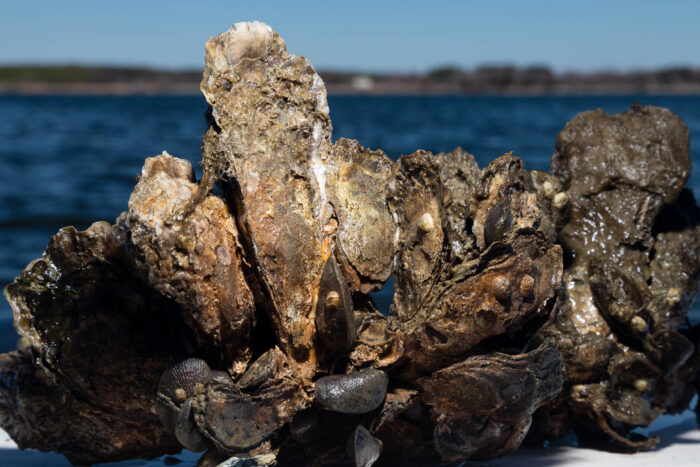Eastern Oyster
Crassostrea virginica
Also known as the American or Virginia oyster, the eastern oyster is a bivalve with two rough, whitish shells. It forms reefs in brackish and salty waters throughout the Chesapeake Bay.
This section shows one large critter image at a time. Use the thumbnails that follow to select a specific image to display here.

This gallery contains a grid of small thumbnails. Selecting a thumbnail will change the main image in the preceding section.
Appearance
Eastern oysters usually grow to three to five inches in length, but can reach a length of eight inches. Two rough shells enclose its soft body and vary in color from white to gray to tan. The right or top shell is flat, while the left or bottom shell is cupped, with a purple muscle scar on the inside.
Feeding
Filter feeders, oysters feed on plankton by opening their shells and pumping water through their gills. This action traps particles of food.
Predators
Oysters are prone to infection by parasites that cause the aquatic diseases MSX and Dermo. They have other natural predators that include:
-
Anemones, sea nettles, and other filter feeders feed on oyster larvae.
-
Flatworms and mud crabs feed on new spat.
-
Blue crabs and some fish feed on older spat and first-year oysters.
-
Shorebirds feed on adult oysters exposed on intertidal flats.
Reproduction and life cycle
Spawning occurs in early summer when water temperatures and salinity levels rise. Adults release eggs and sperm into the water. Females can produce about 100 million eggs each year. After spawning, oysters are thin because they have used up their stored food reserves. Adults grow larger and stronger as the weather cools. In less than 24 hours, fertilized eggs develop into free-swimming larvae.
Over the next two to three weeks, oyster larvae are planktonic (when an organism is too small to propell itself through water). They eventually mature to the pediveliger stage, when they can ‘set’ or attach to hard substrate. Oysters can attach to one another, forming dense reefs (also called oyster bars, beds or rocks) that provide habitat for many fish and invertebrates.
Once larvae find a suitable surface to settle on, they secrete a cement-like substance, which fixes the left shell (also called a valve) into place. Settled juvenile oysters are called "spat." Many oysters change sex over the course of their lifetime. Most oysters less than one year old are male, while most older oysters are female.
Did you know?
- The cavity within an oyster’s shell is always filled with water. This allows oysters to survive for a long time without having to open their shells to feed. During cooler months, oysters can live out of the water for extended periods of time. However, freezing air temperatures will kill them.
- Oysters are one of the most important commercially harvested species in the Chesapeake Bay.
- Historically, oysters were only eaten during months whose names contain an “R.” This is because oyster quality is poor right after they have spawned, and because oysters would spoil without refrigeration during warmer months.
- An adult oyster can filter up to 50 gallons of water in one day under certain conditions.
Sources and additional information
- Life in the Chesapeake Bay by Alice Jane Lippson and Robert L. Lippson
- Chesapeake Bay: Nature of the Estuary, A Field Guide by Christopher P. White
- Animal Diversity Web:Crassostrea virginica – University of Michigan Museum of Zoology
- Eastern Oyster - NOAA Fisheries
